Podcast
Questions and Answers
What directly influences the quality of life of a community?
What directly influences the quality of life of a community?
The success of the local economy
According to Walt W. Rostow, how many categories can all societies be identified as lying within regarding their economic dimensions?
According to Walt W. Rostow, how many categories can all societies be identified as lying within regarding their economic dimensions?
- Three
- Six
- Five (correct)
- Four
According to Rostow, the traditional society is primarily based on attitudes and technology prominent after the turn of the eighteenth century.
According to Rostow, the traditional society is primarily based on attitudes and technology prominent after the turn of the eighteenth century.
False (B)
Which sector dominates the traditional society according to Rostow?
Which sector dominates the traditional society according to Rostow?
Which of the following is NOT a nonindustrial sector that Rostow's precondition stage includes radical changes in?
Which of the following is NOT a nonindustrial sector that Rostow's precondition stage includes radical changes in?
In Rostow's stages of economic growth, what stage is described as a decisive expansion occurring over 20 to 30 years that radically transforms a country's economy and society?
In Rostow's stages of economic growth, what stage is described as a decisive expansion occurring over 20 to 30 years that radically transforms a country's economy and society?
According to Harrod-Domar Growth Model, there are three determinants of the rate of growth of a country.
According to Harrod-Domar Growth Model, there are three determinants of the rate of growth of a country.
In the Lewis model, what is the characteristic of the traditional, overpopulated, rural subsistence sector?
In the Lewis model, what is the characteristic of the traditional, overpopulated, rural subsistence sector?
What is the term for the number of people who are unable to command sufficient resources to satisfy basic needs?
What is the term for the number of people who are unable to command sufficient resources to satisfy basic needs?
What does the United Nations define poverty as?
What does the United Nations define poverty as?
What is the term for the condition of having fewer resources than others in the same society?
What is the term for the condition of having fewer resources than others in the same society?
Which of the following is NOT mentioned as a cause of poverty?
Which of the following is NOT mentioned as a cause of poverty?
What term describes full or partial cancellation of loans from overseas governments and institutions provided to less developed countries?
What term describes full or partial cancellation of loans from overseas governments and institutions provided to less developed countries?
Flashcards
Social Innovation
Social Innovation
Innovative solutions tailored to address specific challenges and needs within a local community, aiming to improve its welfare and quality of life.
Walt W. Rostow
Walt W. Rostow
The most influential advocate of the stages-of-growth model of development.
Stages-of-Growth Model
Stages-of-Growth Model
A model that identifies all societies in their economic dimensions, as lying within one of five categories.
Traditional Society
Traditional Society
Signup and view all the flashcards
Pre-conditions for Takeoff
Pre-conditions for Takeoff
Signup and view all the flashcards
The Takeoff
The Takeoff
Signup and view all the flashcards
Drive to Maturity
Drive to Maturity
Signup and view all the flashcards
Age of High Mass Consumption
Age of High Mass Consumption
Signup and view all the flashcards
Capital-Output Ratio
Capital-Output Ratio
Signup and view all the flashcards
Saving Ratio
Saving Ratio
Signup and view all the flashcards
Lewis Model
Lewis Model
Signup and view all the flashcards
Subsistence Sector
Subsistence Sector
Signup and view all the flashcards
Labor Shift
Labor Shift
Signup and view all the flashcards
Absolute Poverty
Absolute Poverty
Signup and view all the flashcards
Poverty (UN definition)
Poverty (UN definition)
Signup and view all the flashcards
Poverty
Poverty
Signup and view all the flashcards
Relative Poverty
Relative Poverty
Signup and view all the flashcards
Extreme Income Disparities
Extreme Income Disparities
Signup and view all the flashcards
Unemployment
Unemployment
Signup and view all the flashcards
Low Wages
Low Wages
Signup and view all the flashcards
Illness
Illness
Signup and view all the flashcards
Lack of Education
Lack of Education
Signup and view all the flashcards
Corruption
Corruption
Signup and view all the flashcards
Wars and Internal Conflicts
Wars and Internal Conflicts
Signup and view all the flashcards
Age (Poverty)
Age (Poverty)
Signup and view all the flashcards
Study Notes
- The quality of life in a community is directly influenced by the success of the local economy.
- Local economies often face difficulties like limited resources, market access, and a lack of innovation.
- The main goal is to develop social innovation by creating innovative solutions tailored to local needs.
Rostow's Stages of Economic Growth
- Walt W. Rostow was an American economic historian and a influential advocate of the stages-of-growth model of development.
- All societies can be identified within one of five categories in their economic dimensions.
- The five categories are: the traditional society, the pre-conditions for takeoff into self-sustaining growth, the take-off, the drive to maturity, and the age of high mass consumption.
The Traditional Society
- Key aspects include attitudes and technology that was prominent before the turn of the eighteenth century
- Dominated by subsistence agriculture
- Characterized by intensive labor and low levels of trading
- Agriculture is the most important industry.
Pre-condition Stage
- This stage includes radical changes in three nonindustrial sectors for sustained industrialization.
- Increased transport investment enlarges the market and allows for production specialization.
- Revolution in agriculture is necessary to feed a growing urban population.
- An expansion of imports, including capital, can be financed by exporting natural resources.
Take-Off
- This is a decisive expansion occurring over 20 to 30 years that radically transforms a country's economy and society.
- During this stage, barriers to steady growth are overcome, and forces for widespread economic progress dominate.
- Growth is concentrated in a few regions and one or two manufacturing industries.
- The level of investments reaches over 10% of GNP (Gross National Product).
Drive to Maturity
- Characterized as a period of regular, expected, and self-sustained growth.
- The economy is increasing.
- Regular growth and modern technology is extended to a bulk of resources.
- There may be a shift in emphasis from coal, iron, and heavy engineering to machine tools, chemicals, and electrical equipment.
Mass Consumption
- Individual incomes are more than what is necessary for buying essentials.
- Citizens experience high and rising consumption per head, with rewards spread more evenly.
- The service sector becomes more dominant.
- Emphasis shifts from the production of industrial goods to consumer goods.
Harrod-Domar Growth Model
- Every economy must save a certain proportion of its national income to replace worn-out or impaired capital goods.
- There are two determinants of the rate of growth of a country.
- The first is the Capital-Output Ratio, representing the relationship between changes in capital stock and output.
- The second is the Saving Ratio, which considers the relationship between savings and national income.
Lewis Theory of Economic Development
- W. Arthur Lewis formulated a model that focused on the structural transformation of a primarily subsistence economy in the 1950's.
- In the Lewis model, the underdeveloped economy consists of two sectors.
- The first is a traditional, overpopulated, rural subsistence sector characterized by zero marginal labor productivity.
- Agriculture generally under-employs workers, with the marginal productivity of agricultural labor being virtually zero.
- Labor then moves to the more productive, urban, industrial sector.
- Industrialization is now possible, with an increase in the supply of workers who have moved from the land.
- Industrial firms begin to profit, which can be reinvested into further industrialization, leading to capital accumulation.
Problems and Policies
- Absolute poverty is the number of people unable to command sufficient resources to satisfy basic needs.
- It can be measured by the headcount, H, of those whose incomes are below the absolute poverty line, YP.
- The poverty line is set at a constant level in real terms to track progress over time.
Poverty
- Refers to a state of lacking sufficient resources for living and well-being.
- Condition that exists when people lack adequate income and wealth to sustain a basic standard of living
- The United Nations defines poverty as lacking income and productive resources to ensure sustainable livelihoods.
- Poverty as defined by the UN includes hunger and malnutrition, ill-health and mortality from illness, and limited access to education and other basic service
- Poverty also includes homlessness and inadequate housing, unsafe environment and social discrimination and exclusion
Types of Poverty
- Relative poverty is having fewer resources than others in the same society.
- People without certain goods may be considered relatively poor in developed countries, even if they are better off than those in developing countries who survive on less than $3.10 per day, lack shelter, and access to clean water and sanitation.
Absolute Poverty vs. Relative Poverty
| Absolute Poverty | Relative Poverty | |
|---|---|---|
| Definition | Number of people living below a certain income threshold or number of households unable to afford certain basic goods and services. | Measures extent to which a household's financial resources falls below an average income level. |
| Occurence | Occurs when people do not have access to basic food, clothing, and shelter. | Occurs when people are poor when compared to other people in the country, unable to participate fully in normal activities of the society they live in. |
| Impact | People are undeniably impoverished. | People have a lower standard of living in comparison to the normal member of society. |
Why Bother About Inequality
- Extreme income inequality can lead to economic inefficiency.
- Extreme income disparities can undermine social stability and solidarity.
Causes of Poverty
- Unemployment and the loss of income associated with it is one of the main causes of relative poverty in developed economies and absolute poverty in many developing economies
- Low wages are jobs that are low paid but in countries with minimum wages they are not sufficient enough to prevent workers from being poor and unable to buy sufficient goods and services to enjoy a reasonable standard of living
- Illness can reduce life expectancy which is caused by malnutrition and lack of healthcare. Life expectancy measures the average years a person is anticipated to live for based on statistical trends.
- Lack of education causes for an uneducated work force. This can be a bad thing because people may lack prosperity. People who lack education are less employable than those with.
- Corruption is widespread in many less developed countries: causes increases in poverty and exclusion.
- Wars and internal conflicts impacts output/trade that causes resources for funding arms, weapons and armies.
- Age is a key factor in causing poverty. poverty also exists with elderly people and children.
International Measures to Reduce Poverty
| Policy | Why is it needed? | What are the problems? |
|---|---|---|
| Food aid | Poor farming methods produce insufficient food. | Free food supplies can force farmers out of business. |
| Financial aid | LEDCs lack money to invest in an industrial base and machinery. | Loans need to be repaid plus interest. |
| Tech aid | LEDCs lack knowledge of modern production methods. | Many people lack skill in using modern technology - more jobs may be a better solution |
| Debt Relieve | Debt prevents economic growth | Encourages more borrowing or misuse by government |
| Removing Overseas trade Barriers | LEDCs may have natural supplies | Forces down price |
| Economy advice | LEDCs government in lack knowledge of economic | Advice not enough |
Studying That Suits You
Use AI to generate personalized quizzes and flashcards to suit your learning preferences.



